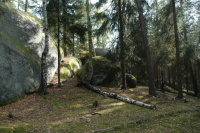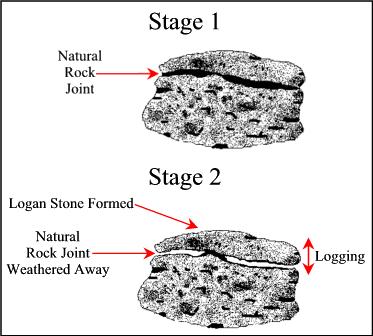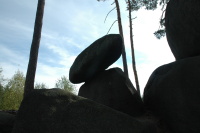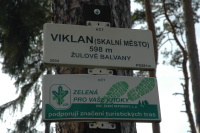The stone village and rock, Kamenne mesto a Viklan EarthCache
The stone village and rock, Kamenne mesto a Viklan
-
Difficulty:
-

-
Terrain:
-

Size:  (not chosen)
(not chosen)
Please note Use of geocaching.com services is subject to the terms and conditions
in our disclaimer.
The stone village and rock
ENGLISCH:
The stone
village
In the Zihle forrest northwest of the village Zihle there is a
tourists sought area of natural monuments U Baby - U lomu, part of
natural park Horni Strela.
This nature sanctuary is the oldest one in the region and was
founded in 1933. The protected area consists of two small separate
sites. In the area called "U Baby" there are two big granite
boulders bearing the names of "Baba" and "Dedek" ("Old woman" and
"Old man"). The second area called "U lomu" ("By the quarry") is
located about 1 km from the first one and is formed with a group of
smaller granite boulders that creates a stone village. Other
smaller stones can be found in the wood westwards from the village
of Zihle.



Rocking Stones (westward from the natural park
Zihle)
There are few such whims of nature that has long enjoyed the
attention of tourists as the rocking stones. Rocking Stones (also
known as logan stones or logans) are large stones that are so
finely balanced that the application of just a small force causes
them to rock. Some of them are so situated that the least touch can
make them rock in one certain direction, but cannot be made to move
in any other by all the force that can be applied to them by
unaided humans.
In a book by Hemery they are described as being: " A rock which,
through weathering, has become disjoined from the parent-rock and
is pivoted upon it... Such rocks can be 'logged', set in motion
without fear of their over balancing."
In other words, a logan is formed when a joint in a granite rock is
eroded by the weather until it gets to a point when enough
weathering has taken place to leave the stone balanced on a small
pivot which enables the stone to rock or 'logg', as show in the
diagram below:

They are found throughout the world. Some are man-made megaliths,
but others are natural, often left by glaciers. Often wear, erosion
or human intervention have resulted in the dislodging of rocking
stones. There are a wide variety of beliefs associated with rocking
stones. Because of their strange nature, rocking stones were
sometimes associated with witchcraft, or Druids. Stones which were
balanced so that the wind could move them were used sometimes in
trials to determine guilt or innocence of the accused.
The Rocking Stones are created by gradual weathering of certain
rock strata, from which only small remnants are remaining in the
form of balanced stones lying on the bedrock with only his small
part. Lots of them can be found in deserts and they are generally
the result of the intrusive activity of the wind that rushing
grains of sands that literally "undercut" foot of the rocks. As you
can read in some travel books describing sandstorms the rocking
stones can sometimes even be moved by the power of wind.
Not all of the stones called "rocking" are really rocking stones in
the true sense. Some of them are still tightly linked with subsoil
even if with their tiniest part, some of them are based on several
spots - in this case they cannot be moved. In addition, only those
"in situ", ie not relocated (by avalanche, collapsing, etc.). are
considered as the "genuine" rocking stones.
Question 1 What kind of stone is Zihle rocking stone?
Question 2 What kind of vegetation grows on the nearby hump?
Question 3 What is the height of the rocking stone?
Question 4 What kind of the tectonic rock can be found around
Zihle?
Question 5 Please insert a photo of yourself, your GPS and balance
boulder
CZECH:
Kamenne
mesto
V oblasti Zihelskeho lesa severozapadneim smerem od obce Zihle je
turisticky vyhledávaná oblast prírodní památky U Báby - U Lomu v
oblasti Prirodniho parku "Horni strela". Toto území je
nejstarším v regionu a bylo vyhlášeno již v roce
1933. Chránenou oblast tvorí dve nevelké oddelené plochy. Na území
nazývané "U Báby" se nachází dva velké žulové balvany, nesoucí
název "Bába" a "Dedek". Druhé území "U lomu" se rozkládá asi jeden
kilometr od první oblasti a tvorí ji seskupení menších
žulových balvanu tvorících skalní mesto. Dalsí mensí balvany
jsou v lese západním smerem od obce Zihle. A tam najdeme i dalsí
balvan jménem "U VIKLANU"
U
VIKLANU
Málokteré kamenné hrícky prírody se odedávna teší takové
pozornosti jako viklany. Vznikají postupným zvetráváním urcité
vrstvy horniny, z níž zbudou pouze male zbytky v podobe
vyvážených balvanu ktere jen svou malou cástí leží na
skalním podloží,takže nekteré lze vetší ci
menší silou rozkývat.



V cestopisných reportážích lícících písecné boure byly dokonce
popisovány viklany rozkývané poryvy vetru. V pouštích je
techto útvaru nejvíce a vesmes jsou zde výsledkem rušivé
cinnosti vetru unášejícího pri zemi zrnka písku a doslova
„podrezávajícího“ úpatí skal.
Vznikají postupným zvetráváním urcité vrstvy horniny, z níž
zbudou pouze male zbytky v podobe vyvážených balvanu, které se
nepatrnou plochou dotýkají podloží.Mívají promenlivou
velikost. Pokud skalni blok spociva nekolika malymi plochami na
podlozi, hovorime o pseudoviklanech. Vyvoj je nejcasteji
vysvetlovan procesy selektivniho zvetravani a odnosu hornin. V
aridnim prostredi je vznik vysvetlovan korazni cinnosti vetru a
pisku.
Vyskytuji se prevazne v oblastech tvorenymi zulami, vzacneji v
piskovcich. Viklany patri k napadnym a pomerne vzacnym mikro a
mezoformam reliefu.
Ne každý útvar oznacovaný jako viklan je však
„kývavým kamenem“ v pravém slova smyslu. Nekteré jsou
dosud pevne spojeny s podložím, byt jen malou plochou, jiné
zase spocívají na podkladu nekolika ploškami – ani v
tomto prípade je nelze rozkývat. Krome toho jsou za
„pravé“ viklany používány pouze útvary v poloze
„in situ“, tedy nepremístené (rícením, v sutích
apod.).


Schéma rozširování puklin v žule pri postupujícím
zvetrávání a konecný vznik izolovaných balvanu na povrchu
žulové krajiny.
Otazka c. 1 Jaky druh kamene je Zihelsky viklan
otazka c. 2 Jakou vegetaci je zarostly pahorek v okoli
viklanu
otazka c 3 Jake ma viklan rozmery - vyska
otazka c 4 Jaka cast tektonickeho podlozi je kolem Zihle
otazka c 5 Foto U VIKLANU Vas, nebo Vasi GPS
Pri spolecne fotce, uvadejte vsichni s kym jste se fotili,
zjednodusuje to pak dohledavani, Dik
Necekejte prosim na mou odpoved, logujte pokud jste odpovedeli na
otazky, jinak logujte pouze WRITE NOTE. A po odeslani odpovedi,
prepnete na FOUND IT. Pokud neco tak o tom budete vedet
Ale prosim neotalejte s odpovedi. Mnozi se pripady logovani po 2
mesicich a to se mi nelibi. Dekuji za pochopeni.
Nehladejte v odpovedi zadnou vedu, koukni se po okoli a odpovidej,
na to nepotrebujete pana Googla.
Pouzita literarura:
http://www.legendarydartmoor.co.uk/Logan_stones.htm
http://en.wikipedia.org/wiki/Rocking_stone
http://www.vesmir.cz/clanky/clanek/id/3292
http://expedice.rps.cz/lokality/25135-Zihelske-kameny-viklan-prirodni-zajimavost.html
Additional Hints
(No hints available.)